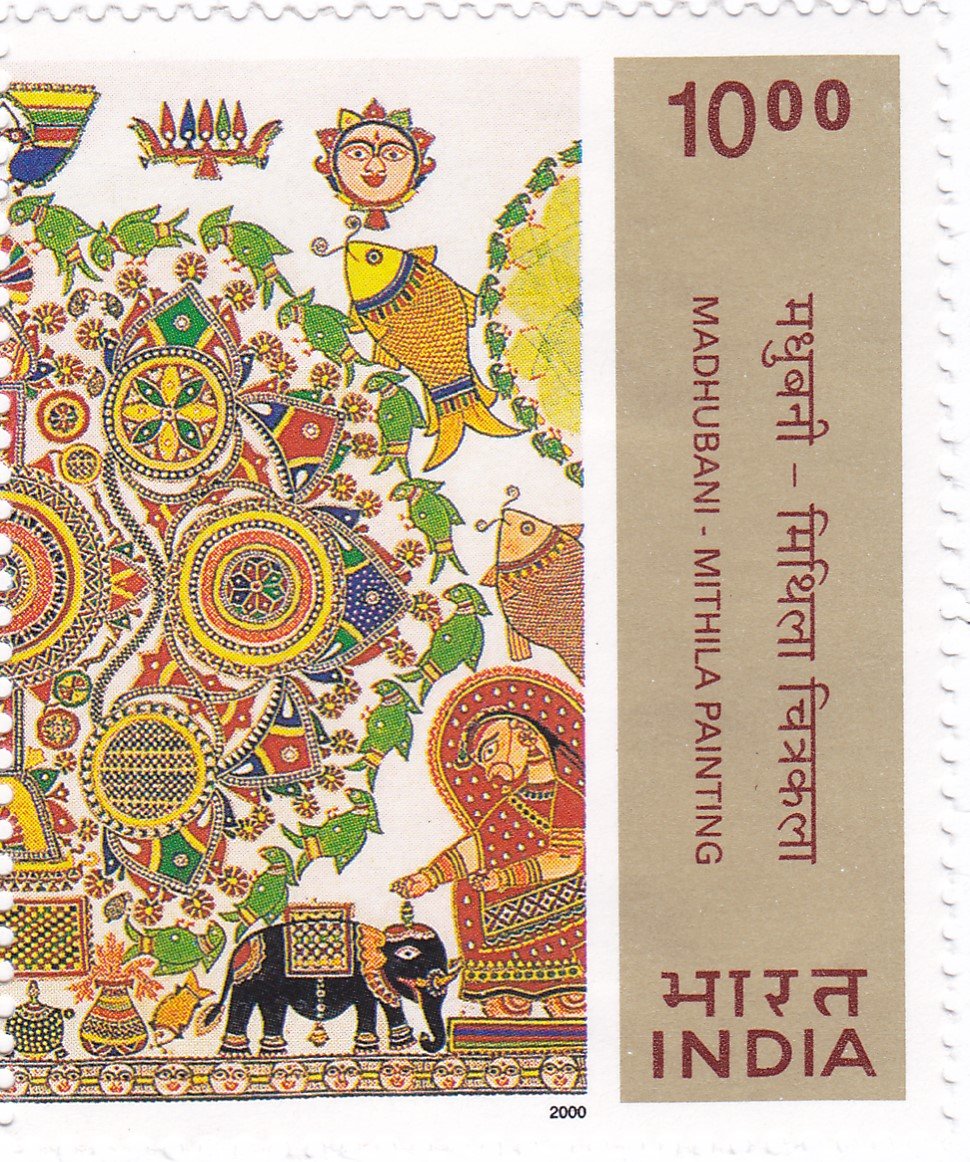“Kohbar Ghar” Mural (Ganga Devi)

Technical Data
| Stamp Set | Madhubani Mithila Paintings |
|---|---|
| Date of Issue | October 15, 2000 |
| Denomination | Rs. 10 |
| Quantity | 3,000,000 |
| Perforation | comb 13½ |
| Printer | Calcutta Security Printers Ltd |
| Watermark | No Watermark |
| Colors | Multicolor |
| Catalog Codes |
Michel IN 1790 Stamp Number IN 1853b Yvert et Tellier IN 1556 Stanley Gibbons IN 1959 |
| Themes | Animals (Fauna) | Art | Elephants | Mammals | Paintings |
Table of Contents
Commemorative Stamp Set: Kohbar Ghar Mural by Ganga Devi
Design Elements:
The Kohbar Ghar Mural stamp is based on the traditional wedding chamber paintings created by Ganga Devi, a master of Madhubani art. This mural, painted at the Crafts Museum in New Delhi, features intricate designs that symbolize life, fertility, and growth, central to the Kohbar Ghar (nuptial chamber) tradition in Mithila culture.
- Central Lotus Plant Motif: Symbolizes fertility, prosperity, and the continuity of life, a central theme in the Kohbar paintings.
- Animals, Birds, and Foliage: Detailed depictions of natural elements, including animals and flora, are emblematic of growth and harmony in life.
- Rich Detailing: Ganga Devi’s work emphasizes the use of minute details, particularly in the rendering of flowers, ornaments, and animals, reflecting the spiritual and celebratory tone of the Kohbar Ghar.
Cultural and Historical Significance:
- Kohbar Ghar Tradition: The Kohbar Ghar murals are typically painted on the walls of a bride’s nuptial chamber and are filled with symbolic imagery representing fertility, love, and the circle of life. The lotus motif, central to this mural, represents spiritual purity and regeneration.
- Madhubani Folk Art: Originating in Mithila, Madhubani art is traditionally done by women on walls and floors during important life events, especially weddings. The paintings serve both aesthetic and ritualistic purposes, embodying local folklore and mythology.
- Role of Ganga Devi: As one of the most respected Madhubani artists, Ganga Devi brought international recognition to this folk art. Her intricate and detailed work elevated the status of Madhubani art and connected it with the contemporary art world.
Usage:
- Cultural Education: The stamp provides a visual representation of the Mithila region’s marriage customs and artistic traditions, acting as a medium for educating the public on rural cultural heritage.
- Commemoration: It commemorates the legacy of Ganga Devi, whose works are revered as prime examples of Indian folk art, specifically in the context of marriage rituals.
- Philatelic Appeal: The detailed designs and cultural significance make it a highly sought-after piece for collectors and art enthusiasts.
Importance of the Commemorative Stamp Set:
- Cultural Preservation: By commemorating the Kohbar Ghar Mural, this stamp set helps preserve a key ritualistic tradition of the Mithila region, ensuring that the symbolic richness of Kohbar paintings continues to be recognized and appreciated.
- Recognition of Women Artists: The stamp highlights the significant contributions of Ganga Devi and the women of Mithila, whose art has played a pivotal role in preserving their community’s cultural identity.
- Cultural Diplomacy: By showcasing folk art on a global platform, India emphasizes its commitment to promoting its rich cultural diversity.
Example of the Stamp Design:
- The stamp features a vibrant lotus plant motif at its center, surrounded by intricate birds, animals, and floral designs. The use of natural colors like red, yellow, and green reflects the traditional pigments used by Ganga Devi, giving the artwork a raw and authentic folk appeal.
The Commemorative Stamp Set Might Include:
- Lotus Plant Symbolism: Highlighting its importance as a representation of fertility and life in the Kohbar Ghar tradition.
- Floral and Animal Motifs: Detailed imagery of birds, animals, and trees that evoke the harmony of nature in the symbolic universe of the Kohbar mural.
Significance:
This stamp set emphasizes the cultural richness of Mithila and celebrates the artistic contributions of Ganga Devi in preserving the Kohbar Ghar mural tradition. It not only honors a key figure in Indian folk art but also promotes India’s diverse cultural heritage on a national and international scale.
